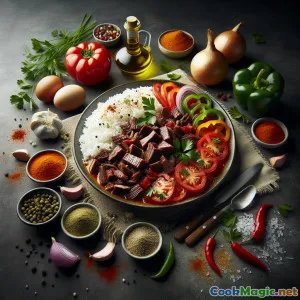
Majadito Cruceño: Nasi Daging Asap Asin Bolivia yang Gurih
(Majadito Cruceño: Bolivia’s Savory Sundried Beef Rice)
(0 Ulasan)0
1,082
Juli 25, 2025
Laporkan Masalah
Bahan
-
250 grams Charque (daging sapi asin kering)
(May substitute with beef jerky if unavailable)
-
300 grams Beras putih panjang
(Rinse well)
-
1 medium Paprika merah
(Dicincang halus)
-
1 medium Bawang bombay putih
(Dihaluskan halus)
-
2 medium Tomat
(Chopped; can use tomatoes in juice for extra flavor)
-
3 cloves Siung bawang putih
(Cincang)
-
3 tbsp Minyak nabati
(Untuk menggoreng)
-
1 tsp Paprika
(Adds color and mild flavor)
-
0.5 tsp Jinten bubuk
(Traditional Bolivian spice)
-
1.5 tsp Garam
(Sesuai selera)
-
0.25 tsp Lada hitam
(Dihalus segar, sesuai selera)
-
4 large Telur
(Fried separately for serving)
-
2 units Pisang hijau
(Peeled and sliced for frying; can substitute with ripe bananas if needed)
-
2 tbsp Peterseli cincang segar
(Untuk hiasan)
-
4 tbsp Saus pedas (Llajwa)
(For serving; traditional spicy Bolivian salsa)
(May substitute with beef jerky if unavailable)
(Rinse well)
(Dicincang halus)
(Dihaluskan halus)
(Chopped; can use tomatoes in juice for extra flavor)
(Cincang)
(Untuk menggoreng)
(Adds color and mild flavor)
(Traditional Bolivian spice)
(Sesuai selera)
(Dihalus segar, sesuai selera)
(Fried separately for serving)
(Peeled and sliced for frying; can substitute with ripe bananas if needed)
(Untuk hiasan)
(For serving; traditional spicy Bolivian salsa)
Nutrisi
- Porsi: 4
- Ukuran Porsi: 1 piring (350g)
- Calories: 630 kcal
- Carbohydrates: 0 g
- Protein: 29 g
- Fat: 26 g
- Fiber: 4 g
- Sugar: 7 g
- Sodium: 1220 mg
- Cholesterol: 205 mg
- Calcium: 110 mg
- Iron: 3.7 mg
Instruksi
-
1 - Rehydrate and Cook Charque:
Place the charque or beef jerky in a pot of boiling water and boil for 20 minutes until softened. Drain, reserve 2 cups of the stock for later, and once cooled, shred the meat finely using your hands or two forks.
-
2 - Prepare the Sofrito:
Heat vegetable oil over medium heat in a large pan. Sauté onions and red bell pepper until soft and translucent. Add minced garlic, stir for 1 minute, then mix in the chopped tomatoes. Stir frequently, cooking until the tomato breaks down and becomes saucy (about 5 minutes).
-
3 - Season and Add the Shredded Beef:
To the sofrito mixture, add shredded charque, paprika, cumin, salt, and pepper. Stir well to allow flavors to meld.
-
4 - Cook the Rice:
Add the rinsed rice to the pan. Pour in the reserved beef stock, and if needed, add extra water so the rice/liquid ratio equals about 1:2. Simmer covered on low heat for 20-25 minutes until rice is cooked and has absorbed the flavors.
-
5 - Fry the Eggs and Plantains:
While the rice cooks, heat remaining oil in a skillet. Fry eggs sunny side up, ensuring the yolks remain runny. In the same pan, fry green plantain slices until golden and crisp on both sides. Drain excess oil.
-
6 - Serve and Garnish:
Spoon heapfuls of Majadito rice onto each plate. Top with a fried egg and a few slices of fried plantain. Garnish with fresh chopped parsley and serve with a side of spicy Llajwa salsa.
Place the charque or beef jerky in a pot of boiling water and boil for 20 minutes until softened. Drain, reserve 2 cups of the stock for later, and once cooled, shred the meat finely using your hands or two forks.
Heat vegetable oil over medium heat in a large pan. Sauté onions and red bell pepper until soft and translucent. Add minced garlic, stir for 1 minute, then mix in the chopped tomatoes. Stir frequently, cooking until the tomato breaks down and becomes saucy (about 5 minutes).
To the sofrito mixture, add shredded charque, paprika, cumin, salt, and pepper. Stir well to allow flavors to meld.
Add the rinsed rice to the pan. Pour in the reserved beef stock, and if needed, add extra water so the rice/liquid ratio equals about 1:2. Simmer covered on low heat for 20-25 minutes until rice is cooked and has absorbed the flavors.
While the rice cooks, heat remaining oil in a skillet. Fry eggs sunny side up, ensuring the yolks remain runny. In the same pan, fry green plantain slices until golden and crisp on both sides. Drain excess oil.
Spoon heapfuls of Majadito rice onto each plate. Top with a fried egg and a few slices of fried plantain. Garnish with fresh chopped parsley and serve with a side of spicy Llajwa salsa.
Informasi Lebih Lanjut: Majadito Cruceño: Nasi Daging Asap Asin Bolivia yang Gurih
Majadito Cruceño de Charque: An Authentic Bolivian Classic
Majadito Cruceño de Charque is one of the most beloved dishes to emerge from the tropical lowlands of eastern Bolivia, notably the region around Santa Cruz. With a base of buttery rice, brightly-seasoned sofrito (a sassy sauté of onions, peppers, and tomatoes), and rich, umami-packed charque (Andean-style sun-dried salt beef), it’s finished with two surprising signatures: crispy, golden fried plantains and a runny-yolked egg on top. This visually stunning dish is a vibrant example of how classic recipes adapt over centuries to local terrain and circumstance, rendering them intricate, nourishing, and distinctly memorable.
A Dish Steeped in History
Charque—sun-dried or salt-preserved beef—has ancient roots in South American foodways. Indigenous Andean peoples, needing to preserve the bounty of their cattle, learned to salt and dehydrate strips of beef in the high-altitude breezes. This invention solved the problem of food security for generations, carrying through colonial times and the dawn of modern Bolivian cuisine. Many attribute majadito’s origins to the cattle-farming region of Santa Cruz, where rice and beef are abundant and culinary imagination is ever resourceful.
Distinguishing Characteristics
What sets Majadito Cruceño apart isn’t simply its list of ingredients—a spectrum of influence from Indigenous Amazonian, Spanish Mediterranean and Andean staples—but the artful layering of flavors and textures. The charque brings a deep, smoky savoriness and a pleasing hint of salinity, while the rice, simmered in beef stock and tomato sofrito, absorbs every ounce of flavor. The modest act of crowning each serving with a fried egg takes this hearty family meal and transforms it into something riveting. Fried green plantains contribute a faintly sweet contrast and some crunch, bathed with the warmth of tropical sunshine.
The liberal use of cumin, garlic, and browned onions offers a true taste of Bolivian terroir. Traditionally, the spicy, herbaceous llajwa (Bolivian chili sauce) is served on the side, providing each diner the freedom to embrace the signature heat level of their choosing.
Cultural Context and Occasions
This dish is most commonly served during special family gatherings, rural festivities, and large religious holidays. Due to the prep required for charque, it’s also historically been a system of thrift—using preserved meats well after the annual slaughters, ensuring no part of the beef goes to waste. For many residents of the Bolivian lowlands, Majadito entries fill home kitchens on cool rainy evenings and exuberant weekend reunions alike—with each cook jealously guarding the secrets to their specific blend of seasoning.
Tips, Notes, & Substitutes
- While traditionalists prize the authentic flavor of charque, beef jerky won’t go amiss—simply soak thoroughly and check sodium before seasoning.
- White medium- or long-grain rice works best, as it keeps its structure in a saucy, robust setting.
- For an even richer flavor, some cooks sauté tomato paste or simmer their rice with chicken stock.
- Plantains provide vital textural and flavor contrast; try them ripe for a hint of sweetness!
- Leftovers are exceptional for breakfast the next day, with another freshly fried egg.
Personal Reflection
While not as internationally recognized as its Andean cousin, the salteña, Bolivian Majadito is an explosion of local color and homegrown ingenuity. Its enduring popularity attests to the resilience and creativity of lowland cooks, whose ability to blend preservation, celebration, and daily staple in a single dish is a kind of culinary poetry. Whether you’re preparing this dish for an adventurous dinner crowd, a homesick Bolivian, or simply for a taste of South American soul, Majadito Cruceño de Charque promises comfort, substance, and a hint of nostalgia served hot—with a wink of the tropics on every plate.





















